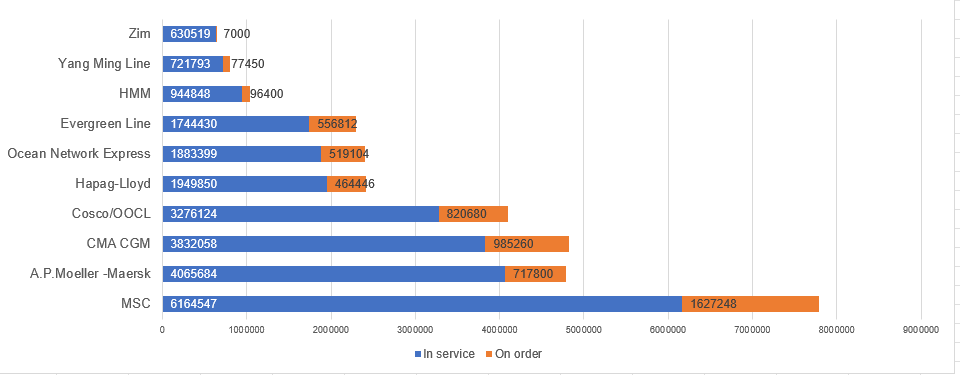
Time:2025-01-23 Popularity:388
Houthi attacks on commercial ships in the Red Sea are likely to continue despite the ceasefire agreement between Israel and Hamas signed Jan. 15, according to a geopolitical expert. Yet one shipping analyst believes if all the deal’s conditions are met, a best-case scenario could see Suez Canal transits resume as soon as next month.
While that best-case scenario was offered by Lars Jensen, CEO of Vespucci Maritime and a Journal of Commerce analyst, the peace deal in Gaza is highlighting the capacity overhang facing container shipping once vessels absorbed by the longer voyages around southern Africa return to the shorter route via the Red Sea and Suez Canal.
Most commercial vessels have avoided the Suez for the past 14 months amid ongoing attacks by Houthi militants operating in Yemen, forcing ships to divert away from the Red Sea to the longer route around the Cape of Good Hope. The Houthis said their attacks were a sign of solidarity with Hamas.
Jensen noted the best-case scenario for shipping would require that the six-week ceasefire that begins Jan. 19 sticks, and that the two other phases of the deal — a full withdrawal from Gaza by Israeli forces and a rebuilding plan in place for the territory — are also met.
“There is no specificity at this point as to whether or when the Houthis will lift their proclaimed embargo against certain groups of merchant vessels passing through the southern Red Sea,” Jensen wrote in a LinkedIn post Thursday.
“It is likely that shipping lines currently diverting around Africa want to see not only the ceasefire hold up ... but also see some meaningful traction on the negotiations for phase two and three of the ceasefire — as well as see some meaningful statements from the Houthis in terms of no longer targeting merchant vessels,” Jensen said.
An analysis by S&P Global Market Intelligence published Thursday noted that the main economic impact of the Red Sea route reopening would be to return capacity to the container shipping system, equivalent to about 6% to 8% of existing vessels. At the same time, new vessels adding nearly 24% of new capacity to the global fleet would be launched over the next three years.
Still, Jack Kennedy, associate director of country risk for the Middle East and North Africa at S&P Global Market Intelligence, parent company of the Journal of Commerce, said the ceasefire would not bring safety to the Red Sea.
“The Houthi are likely to continue to target international vessels in transit regardless of a ceasefire being agreed between Israel and Hamas or end to the wider conflict because it still is an effective means for them to demonstrate internal legitimacy and engage external actors, and secure revenue through protection payments,” Kennedy wrote in a report Thursday. “Even with the ceasefire outlined, there is still going to be an Israeli military presence in Gaza, and what is in effect a blockade of the strip.”
Mediterranean Shipping Co. and the revised carrier alliances have all indicated in their new 2025 schedules that Cape of Good Hope diversions will continue, although Suez transit services were included in the schedules as the preferred option to deploy once it was safe to return to the Red Sea.
Peter Sand, chief analyst at rate benchmarking platform Xeneta, said carriers need to re-assess their risks for Red Sea transits, and while a ceasefire was likely to lower the overall risk, more certainty was needed before shipping’s full return can happen.
“Carriers need some assurance from the Houthi rebels before they begin their return, at first with sub-10,000 TEU ships and the last ones to return will be the 24,000-TEU container ships,” Sand told the Journal of Commerce.
-------------------------------------------------------------------------------------------------------------------------------------------
Top 10 carriers' global existing fleet and capacity on order

Container carriers entered 2025 with a record order book of 8.3 million TEUs that followed the delivery of vessels totaling 2.9 million TEUs in 2024, according to shipping association BIMCO. An average of 1.9 million TEUs in capacity will be delivered every year from 2025 to 2028, peaking at 2.2 million TEUs in 2027, BIMCO noted.
Sand said that when it was safe for carriers to return to the shorter Suez route, 2 million TEUs of container shipping capacity would no longer be needed, leading to large-scale lay-ups, demolition and re-deployment of vessels.
“But none of it, alone or in total, will prevent freight rates from falling to levels seen in early Q4 2023,” he said. “The question is how fast that will be. We expect some operational troubles to keep freight rates volatile for one to two months.”
Sand said while carriers have been good at capacity management in the past few years, the Suez return scenario was “next level.”
“You can’t just be smart and feed 2 million TEUs into other trades and expect no impact,” he said. “Upon return [to the Suez], fundamental overcapacity will reign once again.”
Much of the capacity ordered over the past three years is for vessels greater than 14,500 TEUs that are being steadily deployed on the Asia-Europe trade where all available vessels are being utilized. Virtually no scrapping in the past few years has resulted in the number of ships 20 years old or older reaching 11% of the in-service fleet at 3.4 million TEUs.
“It would require 680,000 TEUs per year to recycle all ships 20 years old or older during the next five years — the current annual record is 657,000 TEUs — but actual recycling is likely to end lower,” Niels Rasmussen, chief shipping analyst at BIMCO, wrote in a report this week, adding that as long as ships could not fully return to the Red Sea, recycling would continue to be low.
Greg Knowler, Senior Editor Europe